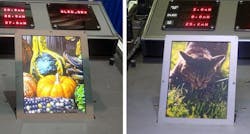Color OLED/reflective LCD hybrid display can be easily seen in full sunlight
Organic LED (OLED) and transmissive liquid-crystal displays (LCDs) are currently used in laptops and mobile devices; although they can be seen well indoors, they are difficult to view outdoors in sunlight. In addition, these displays account for a large percentage of the power consumption of mobile devices.
As noted in Tech-On!, Semiconductor Energy Laboratory (SEL; Kanagawa, Japan) has solved these issues by developing an OLED/reflective LCD hybrid display and exhibited it at SID Display Week 2016 (5/22 to 5/27, 2016; San Francisco, CA). SEL calls it the "TR-Hybrid Display"; The letters "T" and "R" represent "transmissive OLED" and "reflective LC," respectively.
The hybrid display is made by making holes in part of the reflecting electrodes of a reflective LCD. Light emitted from OLEDs attached to the back side of the reflective LCD is transmitted through the holes.
As a production technology for the display, SEL used a delamination technology for flexible OLED displays. First, a peeling layer is applied to a glass substrate for carriage, and thin-film transistors (TFTs) are formed on it. Then, bottom-emission OLED devices are formed to extract light to the TFT side and covered with a flattening film, and a glass plate is placed on it.
After that, the peeling layer is detached, and the glass substrate is removed. Finally, a color filter substrate is attached to the TFT side (without the glass substrate), and a liquid crystal material is injected.
The screen size, pixel count, and resolution of the prototype display are 4.38 in., 768 x 1024 pixels, and 292 ppi, respectively. The LCD and OLED aperture ratios are 76% and 3.9%. To reduce its power consumption as much as possible, SEL used an indium gallium zinc oxide (IGZO) semiconductor for its TFTs, which enables low-frequency operation and can drive OLEDs. For example, the power consumption of the reflective LCD can be reduced to about 1/180 by lowering the drive frequency from 60 Hz to 1/3 Hz.
Moreover, SEL optimized the driving method of the display and improved the display contrast of the OLED from 1,111:1 to 2,850:1. The OLED and reflective LCD are driven independently from each other. Each subpixel of the OLED has two transistors and one capacitor, and each LCD subpixel has one transistor and one capacitor.
Source: http://techon.nikkeibp.co.jp/atclen/news_en/15mk/062100653/
About the Author
John Wallace
Senior Technical Editor (1998-2022)
John Wallace was with Laser Focus World for nearly 25 years, retiring in late June 2022. He obtained a bachelor's degree in mechanical engineering and physics at Rutgers University and a master's in optical engineering at the University of Rochester. Before becoming an editor, John worked as an engineer at RCA, Exxon, Eastman Kodak, and GCA Corporation.

